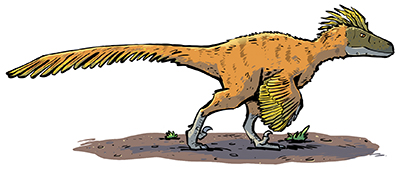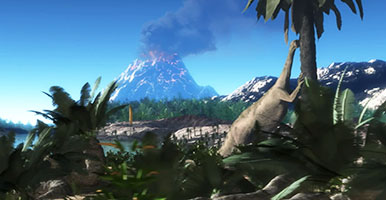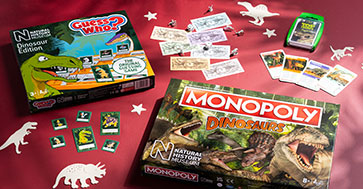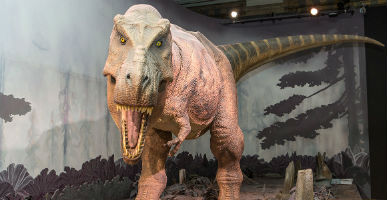Utahraptor
Utahraptor
- Pronunciation:
- YOO-tah-RAP-tor
- Name meaning:
- 'Utah plunderer'


- Type of dinosaur:
- large theropod
- Length:
- 5.5m
- Weight:
- 350kg
- Diet:
- carnivorous
- Teeth:
- lots of sharp, pointed teeth
- Food:
- other animals, including quite big plant-eating dinosaurs such as Hippodraco
- How it moved:
- on 2 legs
- When it lived:
- Early Cretaceous, 139-135 million years ago
- Found in:
- USA
Utahraptor was a meat-eating dinosaur that lived in what's now North America.
It was a member of the dromaeosaur group, like Velociraptor. But Utahraptor was much larger, the largest known member of this group.
It was much stockier than many of its relatives. Some other dromaeosaurs were very small and slim.
Who discovered Utahraptor?
The American scientist Jim Jensen found the first Utahraptor remains in 1975. But the dinosaur wasn't studied in detail until 1991, when another group of researchers - James Kirkland, Robert Gaston and Donald Burge - found more fossils.
As the dinosaur's name suggests, all the known fossils come from Utah in the USA.
The species name, ostrommaysi, is a mash-up of two names. It jointly honours John Ostrom - a renowned dinosaur scientist, and Chris Mays - a special effects expert who helped raise money for Utahraptor research.
James Kirkland considered naming the species after Jurassic Park film director Steven Spielberg, in the hope that Spielberg's production company would help to fund the research project. But the deal never got off the ground and Kirkland ultimately changed his mind.
About eight years after Utahraptor ostrommaysi was named, another scientist adjusted it to ostrommaysorum. But because of the rules on how animal species are named, this was wrong and scientists say ostrommaysi should be used.
How big was Utahraptor?
At 5.5 metres long, Utahraptor was a very large dromaeosaur.
Whereas its smaller relatives such as Velociraptor and Bambiraptor were slender and agile, Utahraptor was a heavy, bulky animal.
But it wasn't the only big dromaeosaur. Achillobator, Austroraptor and Dakotaraptor also reached large sizes.
Was Utahraptor intelligent?
In popular culture, dromaeosaurs - often known as 'raptors' - have a reputation for intelligence. Jurassic Park shows Velociraptor as smart enough to solve puzzles and open doors.
In reality, Utahraptor and its relatives may have been a little bit cleverer than other dinosaurs, but not much.
They had slightly larger brains relative to their body size, but this isn't a very reliable way to predict intelligence. A large brain may mean an animal is clever, or it may mean that it has very good vision or hearing. Brainpower can be as important for these senses as the eyes and ears.
Most modern birds probably have a more developed brain than Utahraptor. But nobody knows for sure.
How fast was Utahraptor?
Scientists think it's unlikely that Utahraptor was very fast. It may have used an ambush style of hunting.
Although smaller dromaeosaurs would have been very agile, Utahraptor probably wasn't very good at jumping or pouncing, as it was so much bigger and heavier.
Did Utahraptor have feathers?
We don't have any direct fossil evidence that Utahraptor had feathers.
However, it seems likely that all dromaeosaurs were covered in feathers. So, Utahraptor almost certainly had them too.
Utahraptor in popular culture
A female Utahraptor was the main character of Robert Bakker's 1995 novel, Raptor Red. Set in the Cretaceous Period, the book mixes science and make-believe to describe the trials and tribulations of one dinosaur as she and her pack try to survive and look after their young.
Perhaps unsurprisingly, Utahraptor is also the state dinosaur of Utah. This honour was given after a 10-year-old student petitioned the Utah Senate in 2018 to replace Allosaurus as the state fossil.
The senators decided to keep Allosaurus as the official fossil, but they were so impressed by the proposal they added a new state symbol - the state dinosaur - for Utahraptor.

© The Paleoart of Julius Csotonyi published by Titan Books
Taxonomic details
- Taxonomy:
- Dinosauria, Saurischia, Theropoda, Dromaeosauridae
- Named by:
- Kirkland, Gaston and Burge (1993)
- Type species:
- ostrommaysi

Step back in time
Find out more about dinosaurs' lives and the world they lived in.

Fun and games
Learn more about dinosaurs through toys, board games and activity kits, available from our online shop.

Dinosaurs gallery
Roarrr. Come face-to-face with some of the Museum's most famous dinosaurs.




